Most beginning artists, will, at some point, find themselves in the art supplies store staring at a wall of artist brushes. All different shapes, sizes, and price ranges.
The choices can be a little daunting, even for someone who has been painting for a while. How do you choose the right brushes to start off with and what are all the various sizes and shapes used for?
I will try and take a little of the mystery out of this magical wall of hog hair and synthetics for you in this article.
This is by no means a comprehensive review, but it should help you choose the right artists’ brushes to start your painting journey.
**This page may contain affiliate links to products I have used or recommend. If you purchase something from this page, I may receive a small percentage of the sale at no extra cost to you. For more information click here.**
Brush Shape
There are many different shapes of brushes you can buy. I have provided a brief explanation of each below.
My recommendation for beginners is to pick up a flat brush, a filbert brush, and a round brush. You may also want to get two large brushes, one for gesso and one for varnishing.

Flat Brushes: these artist brushes are square-topped and used to paint large areas with broader strokes. If applying delicate pressure, they can be used on their edge to make lines.

Brite Brushes: similar to a flat but shorter. The edges curve slightly inwards at the tip. Used for making shorter strokes in smaller areas. Great for detail work and painting small areas.

Filbert Brushes: oval-shaped, this artist’s brush gives smoother coverage than a flat brush with less chance of seeing brush strokes. Good for blending.

Round Brushes: used for detail and sketching, these brushes are thick at the ferrule ( the little silver part that holds the bristles together) and taper to a point at the tip. You can achieve a thick or thin line with this brush depending on how much pressure you apply.

Fan Brushes: shaped like its name, the fan brush is ideal for painting foliage, clouds, a field of flowers, and other textures.

Angle Brushes: these are basically flat brushes with an angled end. It is a good brush for shading and getting into tight places like the corners of a window.

- Detail Brushes: these are small, thin brushes used for fine details. They can have long or short hairs. It is much easier to get fine lines with a detail brush than with a round brush.
- Personally, I prefer the long-haired detail brush. The shorter hairs don’t hold enough paint and the paint more easily gets into the ferrule and makes the bristles spread out, making it unusable for fine detail. This is something you should look for when choosing brushes.

Mop Brushes: these brushes look like a fluffy mop. They are used for blending out brush strokes. It is best to hold this brush at the end of the handle and lightly blend the brush strokes out.

Cats’ Tongue: this is a relatively new type of specialty brush that is shaped like a cats’ tongue, wide and flat at the ferrule and pointed at the tip. It is great for painting leaves, flowers, and other similar shapes.

- Large Brushes: these brushes are great for painting washes or backgrounds on large canvases. They are also great for applying gesso to a canvas or varnish to a finished painting.
- You can get specialty brushes for these jobs but they are expensive. I just purchase large 2-3 inch brushes at the hardware store.
- They work just as well for half the price. Just take the time to test the bristles and watch for hairs falling out.
You should also have separate brushes dedicated for gesso and another one or two for applying varnish so you don’t contaminate your varnish with paint or gesso.

Brush Bristles
Although an type of bristles can be used with any type of paint, certain bristles are more suited to certain types of paint and painting styles.
When choosing brushes you should make sure to choose the ones suitable for your painting medium.
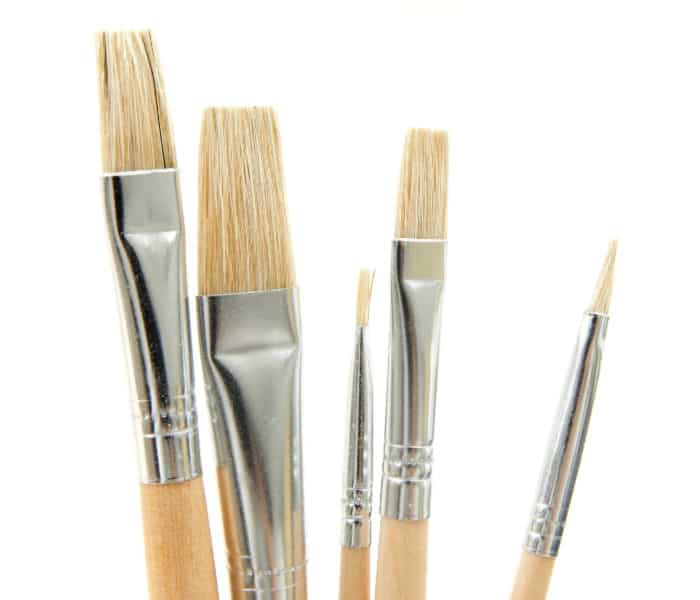
Stiff Bristles
Stiff hog hair brushes are generally used for oil painting and thicker applications of acrylic paint. The strong bristles are ideal for moving around thick layers of paint and will leave visible brush strokes when desired.
There are both natural hog hair and synthetic hog hair brushes available if you prefer not to use brushes made from animal hair.

Soft Bristles
The soft hair of sable or mongoose brushes is best for watercolor and very thin applications of paint such as soft body paint. They absorb a lot of water and move the paint around more easily.

Synthetic Bristles
Synthetic brushes are made of nylon or polyester filaments. They are the most often used brushes for acrylic painting. See my post on Acrylic Painting Techniques for more information on different brush techniques.
These brushes can also be used in oil paintings and watercolor, .
Below is a chart of the most common artists’ brushes. Click to download and print.

Choose Artists’ Brushes That Work for You
Ultimately, when choosing brushes, it comes down to how it feels in your hand. Keep in mind the uses for each brush, the medium you use and your style of painting.
Pick up a brush, make a few strokes in the air and see how it feels. Long handles will give you a loose stroke while the short handles will enable you to get closer and paint more detail.
There are a lot of different brands and prices to choose from. Something in the low to mid price range is a good choice for a beginner.
Use the right brush size for the job. Don’t try to paint a background with a tiny detail brush. Each of the brushes described above comes in different sizes, so choose the one to fit the size you will be painting.
There are a lot of different brands and prices to choose from. A good quality brush in the low to mid-price range is a good choice for a beginner.
Pick up a few different brushes whenever you go to the art store. Over time you will find your favorites and build up a collection.
You don’t need a hundred brushes, just a handful that you can work well for any painting.
I started out with a set like this one and they worked well for me to begin with. I picked up more brushes over time as I gained more knowledge about how the paint worked and how I could use the brushes to make different effects.
To learn how to properly care for your brushes, check out my post on Brush Cleaning Basics.

One Last Point On Choosing Artists’ Brushes
I never recommend the cheap dollar store brushes. These are great for crafts but not for fine art.
As a new painter, these brushes can be very frustrating and may even give you the impression that you are not a good artist.
They are made of poor quality materials and the bristles fall out easily and get embedded into your painting. They leave streaks in the paint and never hold a point for long.
Remember, you get what you pay for so when choosing brushes, get the best ones you can afford.
If you have questions, you can leave them in the comments below. You can also join our free Facebook group, Trembeling Art Creative Corner, where you can ask questions, post your work and get to know some fantastic artists from all genres and skill levels. 😊
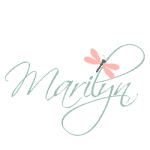
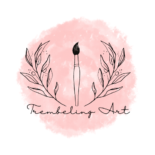
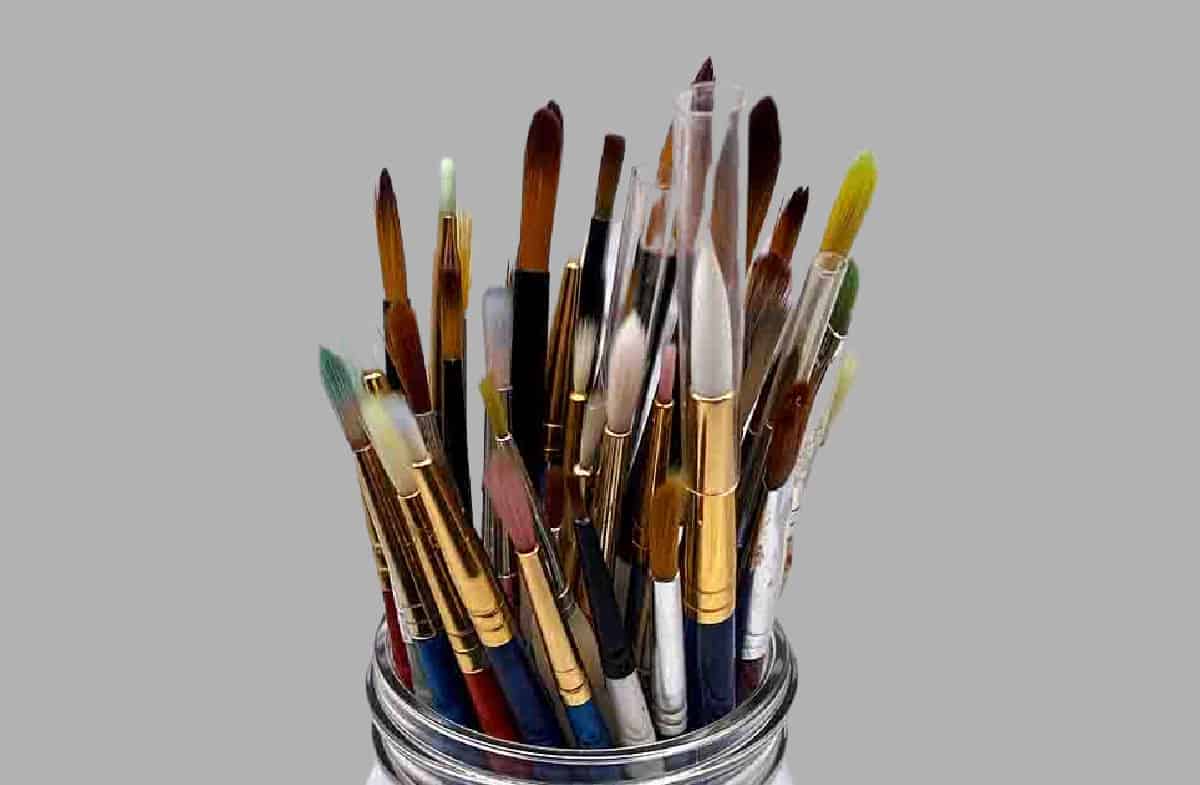
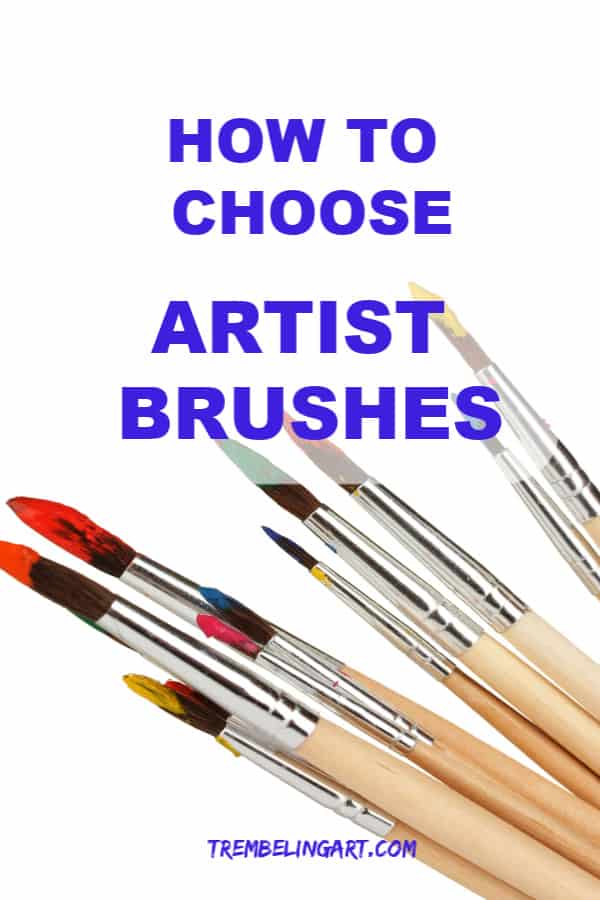

Hi Marilyn, I have many physical challenges so you are very encouraging. I am seventy years old and I have finally gotten around to painting lessons. I have been a quilter for 40 years but I haven’t been able to get interested in a project for some time now. When the opportunity presented itself for me to take lessons I decided now is the time and I am so happy I did. We have a wonderful teacher who makes the rounds to neighboring Senior Centers to teach painting. She encourages us, there is no pressure. I don’t know how long I will be able to continue but for now, it is a great pleasure.
Is there a difference between synthetic and nylon bristles?
Hi Alma; Synthetic and nylon are the same thing. Any synthetic or nylon brush is ok to use with acrylics. Some are really stiff and some are really soft. I find a brush that is somewhere in-between is the best to work with. Hope this helps. 🙂
Thank you for the info. I am a beginner for sure, and also learning to live with medical impairment.
Hi Alma; Thank you. There are a lot of challenges with learning to paint and draw when you have an impairment, but art is great therapy. I am glad I can provide a little bit of help to others as I learn more myself. Thank you and take care. 🙂
Hello